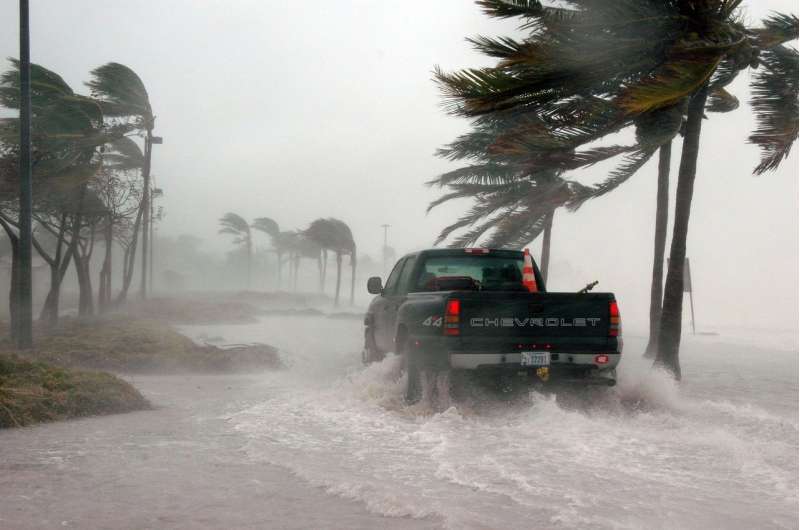Over recent decades, there was a large variation in cyclone-related excess deaths by hurricane, state, county, year, and social vulnerability for counties in the United States, with 83% of hurricane-related deaths occurring more recently and 94% in more socially vulnerable counties.
Results of a study by researchers at Columbia University Mailman School of Public Health, Colorado State University, Imperial College London, University of California Irvine, and Harvard T. H. Chan School of Public Health are published in the journal Science Advances.
The study exemplifies how variable the impacts of even the same tropical cyclone have been, driven differences in by demographic, economic, and social factors. Total excess deaths were particularly high in counties the largest proportion of minorities.
Until now, there had been a critical knowledge gap about estimating post-cyclone excess deaths with a consistent methodology from a large-scale study covering the entire United States across multiple decades.
The researchers found that the single largest number of excess deaths was in Orleans Parish, LA, after Hurricane Katrina in 2005, with 719 excess deaths. followed by Harris County, TX, after Hurricane Rita in 2005 (309 excess deaths), Broward County, FL, after Hurricane Matthew in 2016 (185 excess deaths), and Nassau County, NY, after Hurricane Sandy in 2012 (178 excess deaths).
The most estimated excess deaths in a single year were during 2005, with 2,163 estimated post-tropical cyclone excess deaths, with 1,491 from Hurricane Katrina in 2005. Where probabilities of excess deaths were high, 83% of post-hurricane-force and 70% of post-gale-to-violent-storm-force excess deaths occurred more recently (2004–2019); and 94% were in more socially vulnerable counties.
“In our study, excess death counts after tropical cyclones were higher more recently and for the most socially vulnerable,” said Robbie M. Parks, Ph.D., assistant professor of Environmental Health Sciences at Columbia Public Health, and first author. “This was likely in part due to lack of access to adequate short-term transportation, as well as inequitable access to financial resources, education, employment opportunities and timely warnings on tropical cyclone proximity, all of which are results of long-term institutional neglect.”
Knowledge of short-term excess deaths—i.e., the difference between the observed number of deaths in the immediate aftermath post-tropical cyclone and the number of deaths had a cyclone not occurred—is essential for understanding the public health burden of climate-related disasters and a key recommended measure for post-disaster mortality assessment, note the authors.
Following a tropical cyclone, deaths can result from several major causes, including deaths from injuries, infectious and parasitic diseases, cardiovascular diseases, neuropsychiatric conditions, and respiratory diseases. In earlier research published In JAMA and Nature Communications, Parks and colleagues detailed the kinds of causes and risks for death which increased after tropical cyclones.
Using death registration data across four decades and an ensemble of 16 Bayesian statistical models, the researchers estimated the number of excess deaths after tropical cyclones in all impacted areas in the United States including estimates by county, year, tropical cyclone name, and strength of tropical cyclone. Estimated excess deaths in the study were also compared to data from official sources and EM-DAT, the international disaster database.
“Trends of heightened activity and increased intensity of tropical cyclones in recent years indicate that tropical cyclone exposure is and will remain a public health concern,” noted Marianthi-Anna Kioumourtzoglou, ScD, associate professor of Environmental Health Sciences at Columbia Mailman, and senior author.
“Future research may be able to study associations by smaller areal units—ZIP Codes, for example —as appropriate exposure and outcome data become available. It is also essential to prepare for tropical cyclones by accounting for the social determinants of risk and vulnerability of exposed communities, since the most socially vulnerable bear the greatest burden of excess mortality.”
“Our work highlights how deaths are impacted by tropical cyclones, an understudied exposure in relation to public health, and one which will remain an important threat as the climate changes,” observed Parks.
“As a public health priority, future research should focus on understanding the biological and structural drivers of cyclone-related mortality, how to minimize the number of excess deaths related to tropical cyclones, and the impacts on the scale from years to decades.”
More information:
Robbie Parks, Excess mortality in the month of and month following tropical cyclones in the United States, Science Advances (2023). DOI: 10.1126/sciadv.adg6633. www.science.org/doi/10.1126/sciadv.adg6633
Citation:
Study finds greater excess mortality after hurricanes for most socially vulnerable in the US (2023, August 16)
retrieved 16 August 2023
from https://medicalxpress.com/news/2023-08-greater-excess-mortality-hurricanes-socially.html
This document is subject to copyright. Apart from any fair dealing for the purpose of private study or research, no
part may be reproduced without the written permission. The content is provided for information purposes only.


